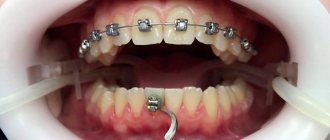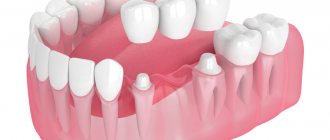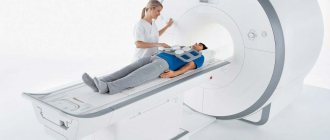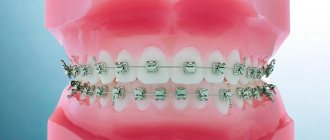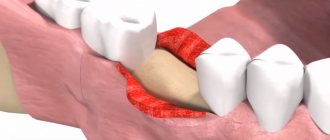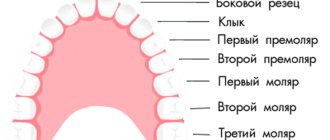A perfect smile that will be the envy of Hollywood stars is the dream of thousands of people. But healthy teeth that have never hurt are very rare. Even if you practice good oral hygiene, there is a risk of dental problems. According to statistics, most teenagers have at least once visited the dentist for caries treatment. But if even children do not mind getting rid of a carious defect, then it is mainly adults who take care of the need to correct the bite.
But many patients are worried about the possibility of installing braces over crowns, fillings and dental implants, doubting the reliability of the structure. GoldenMed dentists claim that it is possible to install a braces system even if there is a hole in the dentition. The main thing is to correctly assess each situation.
Installation of braces on fillings
It is possible to attach an orthodontic structure to filled teeth. To do this, you need to carefully inspect each seal placed. If cracks or chips are found on the surface of the old filling material, a new filling will have to be installed. If the old tabs are not damaged, you can install braces directly on top of them.
The exception is fillings placed in the place where the bite correction system is supposed to be attached. When fixing an orthodontic bracket on the surface of the filling material, due to the high load, it can collapse and break off, making further alignment of the dentition impossible. The presence of such a problem is solved by a dentist individually.
Treating a malocclusion can also cause teeth to be refilled by moving or rotating them, making the filling material more visible or causing the insert to break down.
Care instructions
Without proper care of braces and crowns, problems are unlikely to be avoided. Treatment is impossible without observing a number of important rules, which the attending dentist will definitely tell you about before sending your patient home. It is extremely important to brush your teeth daily, morning and evening, and after all meals and sugary drinks.
To maintain hygiene, both classic brushes with bristles of different hardness, as well as single-tuft options and brushes are perfect. You should also purchase a suitable rinse aid to treat the cavity after cleaning. It will not only remove food particles from hard-to-reach places, but also freshen your breath.
A device such as an irrigator has proven itself to be excellent. Additionally, you can purchase dental floss and therapeutic and prophylactic pastes. Braces need to be cleaned from all sides, paying attention to the areas under the clasps and archwire.
previous post
Why get braces?
next entry
Is it possible to put braces on crowns?
Installation of orthodontic brackets on an artificial crown is also possible. Treatment of malocclusion occurs thanks to living roots under the prosthesis, capable of moving in the direction specified by the brace system.
But most likely you will have to give up wearing inconspicuous lingual or aesthetic ceramic models, opting for a metal structure. This is due to the better adhesion of a metal lock to the surface of an artificial crown in comparison with retention elements made of other materials.
You will also have to carefully care for the oral cavity until the correct bite is formed, protecting the braces from mechanical stress. It is worth giving up hard, sticky foods, taking care to maintain a reliable fixation of the system.
Attaching a bridge prosthesis to supporting teeth is also not a problem. The orthodontist may recommend temporarily removing the bridge and installing temporary crowns, or suggest sawing the prosthesis into several parts to protect it from destruction.
Is it possible to move the teeth on which the bridge rests?
It is possible to normalize the bite in the presence of a bridge prosthesis, but this will require a certain preparatory period.
- To prevent the solid structure from collapsing during orthodontic treatment, it can be cut into separate elements.
- There is another option: the bridge is removed and replaced with temporary plastic crowns during the correction.
During the treatment of patients with crowns and bridges, additional problems may arise. Thus, the surface of the crown will almost certainly change its appearance - it will become rough and darken. Therefore, after removing the braces, it will have to be put in order - polished. A crown removed before treatment cannot be reinstalled, because the position of the teeth will no longer be the same as at the time the impression was taken to make it.
Installation of braces on implants
It is also possible to place an orthodontic structure on dental implants, but it is worth considering that the artificial tooth root is immovable. During implantation, it is implanted in a position that optimally matches the position of the dentition. But if the living roots remain mobile and can move slightly under the load of the braces system, the artificial tooth can only fall out.
Therefore, it is better to correct the bite with braces before implantation. But if implants are installed, the decision on the possibility of installing an orthodontic bracket is made by the dentist based on individual calculations.
Braces and implantation. Wearing braces and implants together – is it possible or not?
Content:
- Installing an implant while wearing braces
- Braces and implantation
- Is it possible to put braces after implantation?
Many patients in dental clinics require not only bite correction, but also restoration of lost teeth. Therefore, a natural question often arises: “Is it possible to install an implant during braces?” Orthodontics and implantation are combined techniques, but each clinical case is individual. Let's look at how to properly combine these two technologies.
Braces for missing teeth
Even the removal of one or more teeth is not an obstacle to creating a perfectly straight smile. The possibility of installing braces depends on the individual clinical situation. If there are no teeth necessary to fix the bracket, the doctor may suggest preliminary implantation, taking into account the subsequent load on the implant.
The patient's goal and the extent of the defect are also important. If you need to straighten your front incisors, the brace can be easily installed even if other teeth are missing. But if you wanted to close a hole from a lost tooth in this way, then even the most experienced dentist will not be able to help due to the impossibility of predicting the result.
When deciding whether or not to install an orthodontic appliance for each individual patient, the orthodontist must consider many factors, including the current alignment of the teeth, the strength of the restoration, the ability to securely attach the bracket, and the achievement of the patient's goals.
Medical dentists have extensive experience in installing orthodontic structures in a wide variety of clinical cases. High qualifications and constant interest in new methods in dentistry will help our doctors give you the perfect smile.
Planning the result
At this stage, the orthodontist realistically evaluates all the diagnostic results obtained and calculates the order of the upcoming installation of braces. A decision is made about whether teeth need to be installed before braces. All stages and the order of their implementation are discussed with the patient.
The time of wearing the corrective structure depends, first of all, on the complexity of the deformation of the dentition.
This process is always purely individual. The average duration of treatment is from 12 to 24 months.
If necessary, the patient receives a referral to other specialized specialists for complete comprehensive sanitation of the oral cavity. At Narodnaya Dentistry, all specialists work harmoniously and purposefully. Having our own modern equipment allows us to make a diagnosis in the shortest possible time and begin treatment immediately.
A complex approach
Numerous dental problems require the joint work of several dental specialists: an orthodontist, a therapist and a surgeon. An integrated approach allows treatment to be carried out in a shorter period of time.
What do doctors usually offer to patients who need both braces and implants? First you need to undergo an examination, after which you can create an individual treatment plan. Most likely, the patient will have orthodontic braces installed in the first stage, and implantation may be performed before they are removed. The dentist will place the pin and crown without affecting the design of the braces.
However, the patient will have to come to see the doctor more often. In addition, this approach significantly complicates the process of caring for teeth and braces. You will have to purchase a special brush for caring for implants and orthodontic braces, as well as an irrigator with attachments for such systems. But it becomes possible to get rid of several dental problems at once. Otherwise, the treatment will be very long: first orthodontic, and then surgical. This can take from 1.5 to 3-4 years, depending on how long the braces were installed.
Operating principle
To correct the bite, structures made of various materials (metal alloys, ceramics, etc.) are used. The metal wires apply even pressure on the teeth, causing them to snap into place. The metal triggers activity at normal basal temperature, and the pressure on each tooth is calculated by the orthodontist.
In this case, the pressure is not applied to the tooth itself, but to a certain area glued to its surface using special glue. The platform can be made of various materials. In this case, it means pressure on intact teeth (not subject to correction).
Specifics of orthodontic treatment in the presence of dentures
Installing a braces system on an artificial surface is more difficult than on a real tooth. The fixation of an orthodontic structure on dentures has its own characteristics:
- Locks do not adhere well to artificial material, so before fixing, the dentist carries out additional surface treatment.
- This treatment may result in loss of smoothness and uniform color.
- If there is an implant, braces are most often not installed.
- After correction of the bite, the denture may no longer fit in shape.
- Under the pressure of the metal arc of the bracket system, the crown may fall off.
Thus, permanent artificial crowns, although not an absolute contraindication to orthodontic treatment, do complicate it. The patient will either have to change them after bite correction, or the doctor will not be able to move the teeth in the desired direction. The best option is to install braces on temporary crowns and then replace them with permanent ones.
What to do if several teeth are missing in the mouth and bite correction is required?
Let’s say a patient is missing two upper teeth and has a malocclusion, is it possible to simultaneously perform implantation and treatment with braces?
In the upper jaw, after tooth extraction, an acute deficiency of bone tissue almost always occurs. Before implantation, the doctor is required to perform a sinus lift to reconstruct the correct geometry of the jaw bone.
At the preparatory stage of complex treatment, a template for the future result of prosthetics on implants is created, thanks to which the orthodontist immediately sees the possibilities and prospects for moving teeth.
Implantation, bone augmentation and orthodontics in such situations must proceed in parallel. The ideal option is a system of full-fledged comprehensive planning of the result - when a team of doctors decides which department of the clinic will play the leading role in quick and error-free reconstruction of the bite.
Is this option possible in our case: first, place braces only on the lower jaw, simultaneously carry out a sinus lift and implantation, and then straighten the upper teeth?
Yes, this is possible, but it should be taken into account that fractional treatment will take longer. A combination of techniques, on the contrary, will provide quick correction.
As an option, you can wait for the result of sinus + implantation on the upper jaw, and then simultaneously carry out orthodontic correction both above and below. There is little point in separate correction without antagonists. This is suitable for optimizing costs, but for optimizing treatment it will be useless.
Useful tips about dental implantation from an orthodontist
The most important recommendation to patients is to try to preserve their teeth for as long as possible. Don’t rush to remove them, strive to treat them, even if their lifespan after that is five to seven years. Your own teeth are always better than the highest quality and most beautiful crowns and implants.
If dental implants are being considered, it is helpful to review the following recommendations from your orthodontist:
- Do not delay installing an artificial root if necessary. Timely restoration of the integrity of the row will prevent loss of bone tissue in the area of the formed defect and stop the movement of neighboring units to the empty space.
- Listen to your specialist if he recommends not installing an implant in favor of moving the remaining molars. The orthodontist may suggest, for example, to move the “eight” to the place of the seventh unit, and it, in turn, should be directed towards the removed “six”. This technique is not used often, but sometimes it makes sense.
- Make sure that implantation and orthodontic treatment are carried out by the same team of specialists.
It is very important that the orthodontist and surgeon communicate with each other. We jointly developed a competent, well-thought-out treatment plan and followed it. This can only be done if implants and braces are installed in the same clinic, with preliminary treatment planning in which all specialists participate.
